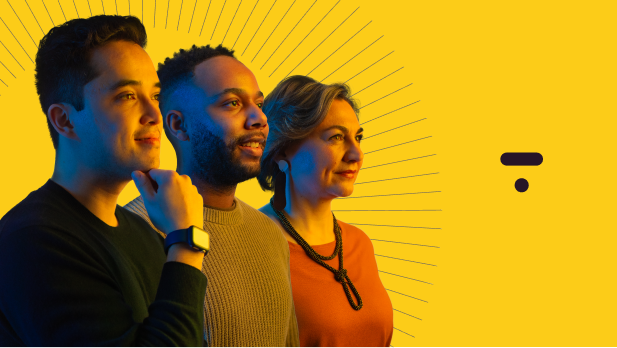When it comes to learning something new, we all absorb information at different rates and understand it differently too. Some students get new concepts right away; others need to sit and ponder for some time before they can arrive at similar conclusions.
Why? The answer lies in the type of learning styles different students feel more comfortable with. In other words, we respond to information in different ways depending on how it is presented to us.
Clearly, different types of learning styles exist, and there are lots of debates in pedagogy about what they are and how to adapt to them.
For practical purposes, it’s recommended to ensure that your course or presentation covers the 7 main types of learning.
In this article, we’ll break down the 7 types of learning styles, and give practical tips for how you can improve your own teaching styles, whether it’s in higher education or an online course you plan to create on the side.
Skip ahead:
-
What are the 7 types of learning styles?
How to accommodate different types of learning styles online
How to help students understand their different types of learning styles
What are the 7 types of learning styles?
In the academic literature, the most common model for the types of learning you can find is referred to as VARK.
VARK is an acronym that stands for Visual, Auditory, Reading & Writing, and Kinesthetic. While these learning methods are the most recognized, there are people that do not fit into these boxes and prefer to learn differently. So we’re adding three more learning types to our list, including Logical, Social, and Solitary.
Visual learners
Visual learners are individuals that learn more through images, diagrams, charts, graphs, presentations, and anything that illustrates ideas. These people often doodle and make all kinds of visual notes of their own as it helps them retain information better.
When teaching visual learners, the goal isn’t just to incorporate images and infographics into your lesson. It’s about helping them visualize the relationships between different pieces of data or information as they learn.
Gamified lessons are a great way to teach visual learners as they’re interactive and aesthetically appealing. You should also give handouts, create presentations, and search for useful infographics to support your lessons.
Since visual information can be pretty dense, give your students enough time to absorb all the new knowledge and make their own connections between visual clues.
Auditory/aural learners
The auditory style of learning is quite the opposite of the visual one. Auditory learners are people that absorb information better when it is presented in audio format (i.e. the lessons are spoken). This type of learner prefers to learn by listening and might not take any notes at all. They also ask questions often or repeat what they have just heard aloud to remember it better.
Aural learners are often not afraid of speaking up and are great at explaining themselves. When teaching auditory learners, keep in mind that they shouldn’t stay quiet for long periods of time. So plan a few activities where you can exchange ideas or ask questions. Watching videos or listening to audio during class will also help with retaining new information.
Reading and writing (or verbal) learners
Reading & Writing learners absorb information best when they use words, whether they’re reading or writing them. To verbal learners, written words are more powerful and granular than images or spoken words, so they’re excellent at writing essays, articles, books, etc.
To support the way reading-writing students learn best, ensure they have time to take ample notes and allocate extra time for reading. This type of learner also does really well at remote learning, on their own schedule. Including reading materials and writing assignments in their homework should also yield good results.
Kinesthetic/tactile learners
Kinesthetic learners use different senses to absorb information. They prefer to learn by doing or experiencing what they’re being taught. These types of learners are tactile and need to live through experiences to truly understand something new. This makes it a bit challenging to prepare for them in a regular class setting.
As you try to teach tactile learners, note that they can’t sit still for long and need more frequent breaks than others. You need to get them moving and come up with activities that reinforce the information that was just covered in class. Acting out different roles is great; games are excellent; even collaborative writing on a whiteboard should work fine. If applicable, you can also organize hands-on laboratory sessions, immersions, and workshops.
In general, try to bring every abstract idea into the real world to help kinesthetic learners succeed.
Logical/analytical learners
As the name implies, logical learners rely on logic to process information and understand a particular subject. They search for causes and patterns to create a connection between different kinds of information. Many times, these connections are not obvious to people to learn differently, but they make perfect sense to logical learners.
Logical learners generally do well with facts, statistics, sequential lists, and problem-solving tasks to mention a few.
As a teacher, you can engage logical learners by asking open-ended or obscure questions that require them to apply their own interpretation. You should also use teaching material that helps them hone their problem-solving skills and encourages them to form conclusions based on facts and critical thinking.
Social/interpersonal learners
Social or interpersonal learners love socializing with others and working in groups so they learn best during lessons that require them to interact with their peers. Think study groups, peer discussions, and class quizzes.
To effectively teach interpersonal learners, you’ll need to make teamwork a core part of your lessons. Encourage student interaction by asking questions and sharing stories. You can also incorporate group activities and role-playing into your lessons, and divide the students into study groups.
Solitary/intrapersonal learners
Solitary learning is the opposite of social learning. Solitary, or solo, learners prefer to study alone without interacting with other people. These learners are quite good at motivating themselves and doing individual work. In contrast, they generally don’t do well with teamwork or group discussions.
To help students like this, you should encourage activities that require individual work, such as journaling, which allows them to reflect on themselves and improve their skills. You should also acknowledge your students’ individual accomplishments and help them refine their problem-solving skills.
Are there any unique intelligence types commonly shared by your students? Adapting to these different types of intelligence can help you can design a course best suited to help your students succeed.
How to help students understand their different types of learning styles
Unless you’re teaching preschoolers, most students probably already realize the type of learning style that fits them best. But some students do get it wrong.
The key here is to observe every student carefully and plan your content for different learning styles right from the start.
Another idea is to implement as much individual learning as you can and then customize that learning for each student. So you can have visual auditory activities, riddles for logical learners, games for kinesthetic learners, reading activities, writing tasks, drawing challenges, and more.
How to accommodate different types of learning styles online
When you’re creating your first course online, it’s important to dedicate enough time to planning out its structure. Don’t just think that a successful course consists of five uploaded videos.
Think about how you present the new knowledge. Where it makes sense to pause and give students the time to reflect. Where to include activities to review the new material. Adapting to the different learning types that people exhibit can help you design an online course best suited to help your students succeed.
That being said, here are some tips to help you tailor your course to each learning style, or at least create enough balance.
Visual learners
Since visual learners like to see or observe images, diagrams, demonstrations, etc., to understand a topic, here’s how you can create a course for them:
-
Include graphics, cartoons, or illustrations of concepts
Use flashcards to review course material
Use flow charts or maps to organize materials
Highlight and color code notes to organize materials
Use color-coded tables to compare and contrast elements
Use a whiteboard to explain important information
Have students play around with different font styles and sizes to improve readability
Auditory/aural learners
Auditory learners prefer to absorb information by listening to spoken words, so they do well when teachers give spoken instructions and lessons. Here’s how to cater to this learning type through your online course:
-
Converse with your students about the subject or topic
Ask your students questions after each lesson and have them answer you (through the spoken word)
Have them record lectures and review them with you
Have articles, essays, and comprehension passages out to them
As you teach, explain your methods, questions, and answers
Ask for oral summaries of the course material
If you teach math or any other math-related course, use a talking calculator
Create an audio file that your students can listen to
Create a video of you teaching your lesson to your student
Include a YouTube video or podcast episode for your students to listen to
Organize a live Q & A session where students can talk to you and other learners to help them better understand the subject
Reading and writing (or verbal) learners
This one is pretty straightforward. Verbal learners learn best when they read or write (or both), so here are some practical ways to include that in your online course:
-
Have your students write summaries about the lesson
If you teach language or literature, assign them stories and essays that they’d have to read out loud to understand
If your course is video-based, add transcripts to aid your students’ learning process
Make lists of important parts of your lesson to help your students memorize them
Provide downloadable notes and checklists that your students can review after they’ve finished each chapter of your course
Encourage extra reading by including links to a post on your blog or another website in the course
Use some type of body movement or rhythm, such as snapping your fingers, mouthing, or pacing, while reciting the material your students should learn
Kinesthetic/tactile learners
Since kinesthetic learners like to experience hands-on what they learn with their senses — holding, touching, hearing, and doing. So instead of churning out instructions and expecting to follow, do these instead:
-
Encourage them to experiment with textured paper, and different sizes of pencils, pens, and crayons to jot down information
If you teach diction or language, give them words that they should incorporate into their daily conversations with other people
Encourage students to dramatize or act out lesson concepts to understand them better
Logical/analytical learners
Logical learners are great at recognizing patterns, analyzing information, and solving problems. So in your online course, you need to structure your lessons to help them hone these abilities. Here are some things you can do:
-
Come up with tasks that require them to solve problems. This is easy if you teach math or a math-related course
Create charts and graphs that your students need to interpret to fully grasp the lesson
Ask open-ended questions that require critical thinking
Create a mystery for your students to solve with clues that require logical thinking or math
Pose an issue/topic to your students and ask them to address it from multiple perspectives
Social/interpersonal learners
Since social learners prefer to discuss or interact with others, you should set up your course to include group activities. Here’s how you can do that:
-
Encourage them to discuss the course concept with their classmates
Get your students involved in forum discussions
Create a platform (via Slack, Discord, etc.) for group discussions
Pair two or more social students to teach each other the course material
If you’re offering a cohort-based course, you can encourage students to make their own presentations and explain them to the rest of the class
Solitary/intrapersonal learners
Solitary learners prefer to learn alone. So when designing your course, you need to take that into consideration and provide these learners a means to work by themselves. Here are some things you can try:
-
Encourage them to do assignments by themselves
Break down big projects into smaller ones to help them manage time efficiently
Give them activities that require them to do research on their own
When they’re faced with problems regarding the topic, let them try to work around it on their own. But let them know that they are welcome to ask you for help if they need to
Encourage them to speak up when you ask them questions as it builds their communication skills
Explore blended learning, if possible, by combining teacher-led classes with self-guided assignments and extra ideas that students can explore on their own.
How to create an online course for all
Now that you’re ready to teach something to everyone, you might be wondering what you actually need to do to create your online courses. Well, start with a platform.
Thinkific is an intuitive and easy-to-use platform any instructor can use to create online courses that would resonate with all types of learning styles. Include videos, audio, presentations, quizzes, and assignments in your curriculum. Guide courses in real-time or pre-record information in advance. It’s your choice.
In addition, creating a course on Thinkific doesn’t require you to know any programming. You can use a professionally designed template and customize it with a drag-and-drop editor to get exactly the course you want in just a few hours. Try it yourself to see how easy it can be.
This blog was originally published in August 2017, it has since been updated in March 2023.





